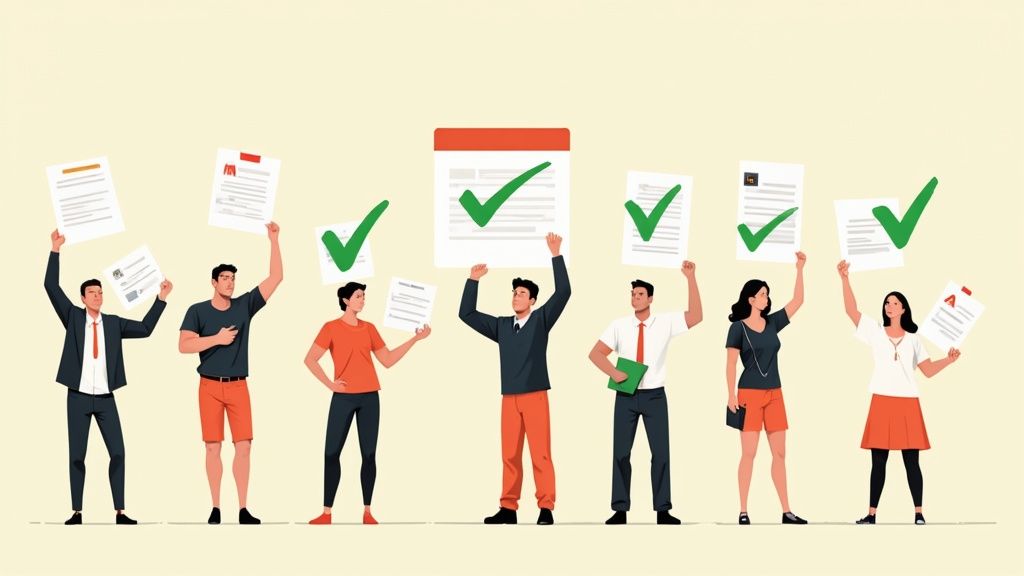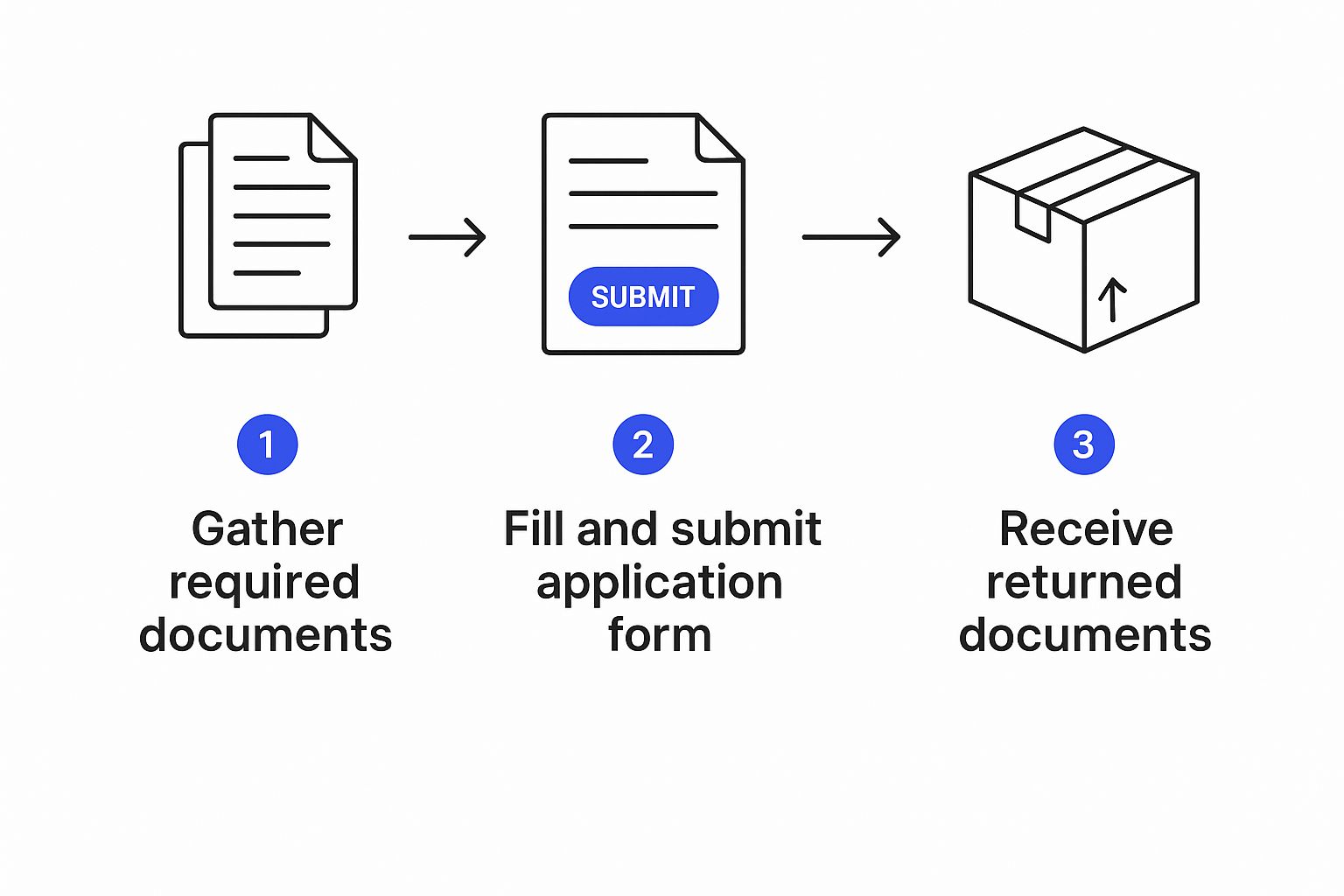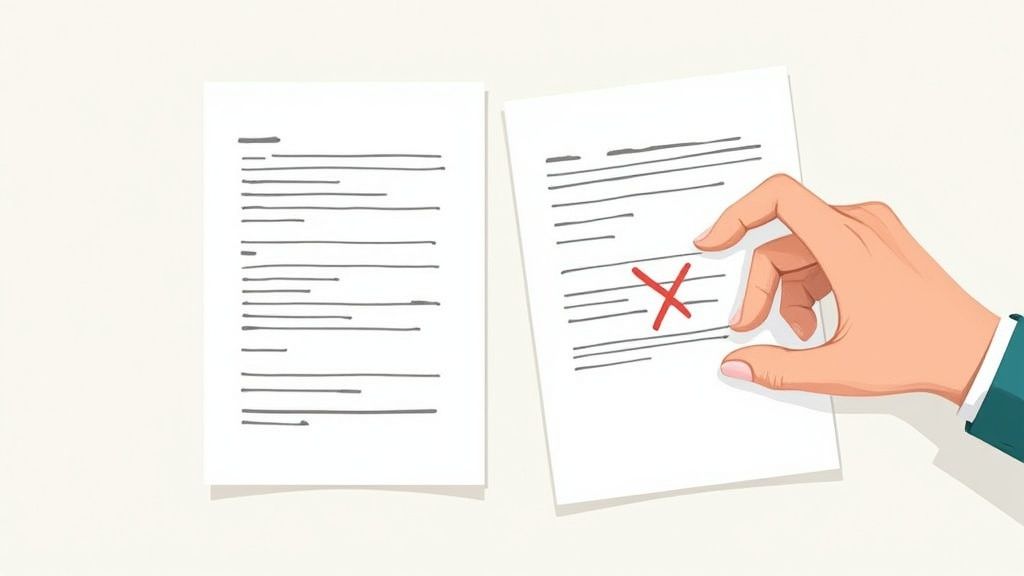Guide to Application for Documents Return in India
- Rare Labs
- Oct 4
- 14 min read
An application for the return of documents is the formal way you ask a court or another official body to give you back original papers you submitted during a legal case. Once a case wraps up, things like property deeds, academic certificates, or other crucial originals don't have to stay locked away in a court file. You can get them back by filing a specific application.
Why You Need to Reclaim Your Documents
Before you even think about drafting this application, you need to be crystal clear on why you're asking. The legal system often needs your original papers as evidence, but once they've served their purpose, you have every right to retrieve them. Knowing the right time and reason to ask is the first step to getting a quick, positive response.
Common Scenarios for Document Retrieval
You'd be surprised how often this comes up in Indian courts and administrative offices. Let's say your property's sale deed was submitted in a civil suit. Once that case is done and dusted, you'll absolutely need that original deed for any future plans, like selling the property or even just applying for a home loan.
It’s not just property papers, either. You might need to get back other vital documents, such as:
Educational Certificates: After they've been verified for a government job or another legal matter.
Identity Proofs: Passports or Aadhaar cards that were submitted for verification.
Business Documents: Original partnership deeds or incorporation certificates you'll need for a new venture after a commercial dispute has been settled.
Financial Papers: Fixed deposit receipts or share certificates that were held by the court during an inheritance case.
InsightsFraming your request around a specific, urgent need can really speed things up with the court registry. Mentioning an upcoming property registration, a visa application deadline, or a pending bank loan adds a sense of immediacy that a generic request just doesn't have.
The Legal Basis for Your Request
Getting your documents back isn't just a courtesy the court extends to you; it's a right grounded in legal procedure. Both the codes of civil and criminal procedure have provisions that allow parties to retrieve their property from the court's custody once it's no longer needed for the case. Tapping into this legal context is key to building a compelling application that makes it clear why your documents should be returned now.
This whole process is a critical piece of many official procedures, from income tax filings to property transactions. It's a system designed to make sure original documents are returned safely after they've been used, reflecting a strong emphasis on secure and efficient handling.
How a Legal AI like Draft Bot Pro Can Help
Let’s be honest, drafting these applications by hand can be a real headache, and it's so easy to make a small mistake. A simple typo in the case number or forgetting to list one of the documents can lead to frustrating delays. This is where modern legal tools like Draft Bot Pro can be a massive help.
You just input your case details, and it can generate a precisely worded application, making sure everything is included and formatted correctly. It’s a modern approach that helps you create a professional-grade request without the stress. In fact, if you're interested, you can learn more about a better way to manage legal documents with these kinds of tools.
Crafting Your Application for Document Return

Getting your application for the return of documents right is less about grabbing a generic template and more about understanding what makes the court machinery tick. A solid application is precise, persuasive, and, most importantly, easy for the court staff to process. That's the real goal here. Let's walk through the essential bits that make an application actually work.
First things first, you have to get the basics perfect. This means the full name of the court, the exact case or suit number, and the names of every single party involved (plaintiffs/petitioners vs. defendants/respondents). Accuracy here isn't just important; it's everything. A single wrong digit in a case number can send your application into a bureaucratic black hole it may never escape from.
Think of this part as the address on an envelope. Get it right, and it lands on the right desk. Get it wrong, and it's lost in the mailroom.
Stating Your Grounds and Prayer
Once you've set the stage with the case details, you need to state the 'grounds' for your request. This is your "why." You're explaining to the court that the case is done and dusted, so those original documents are no longer needed for the record.
You have to be specific about the case's status. Forget vague language. Use clear, direct statements like:
"The aforementioned suit was disposed of/decreed by this Hon’ble Court on [Date of Judgment]."
"The statutory period for filing an appeal against the said judgment has expired, and no appeal has been preferred by any party."
"The original documents, as listed in the annexure, are now required by the applicant for personal/financial/official purposes."
This is where you build your logical case for getting your papers back. After laying out the grounds, you must frame a crystal-clear 'prayer'. This is the formal ask. For instance: "It is therefore prayed that this Hon’ble Court may be pleased to direct the return of the original documents to the applicant." No ambiguity, just a straightforward request.
To help you keep track, here’s a quick rundown of the must-have components in your application. Think of it as a checklist to ensure you’ve covered all your bases before heading to the filing counter.
Essential Components of Your Application
Component | Purpose | Example/Key Information to Include |
|---|---|---|
Court Details | To ensure the application is filed in the correct court and linked to the correct case. | "In the Court of the Civil Judge (Senior Division), Delhi," "Suit No. 123 of 2022." |
Parties' Names | To identify all individuals or entities involved in the original case. | "John Doe (Plaintiff) vs. Jane Smith (Defendant)." |
Grounds for Return | The legal justification explaining why the documents should be returned. | Mentioning the final disposal of the case, expiry of the appeal period, and the applicant's need for the documents. |
Prayer Clause | The specific, formal request to the court for action. | "It is therefore prayed that the original documents be returned to the Applicant..." |
Supporting Evidence | To provide official proof that the case has concluded, validating the grounds for the application. | A certified copy of the final judgment or order. |
Verification & Affidavit | To attest to the truthfulness of the statements made in the application. | "I, [Applicant's Name], do hereby verify that the contents of this application are true to my knowledge." Accompanied by a signed affidavit. |
Getting these parts right isn't just about following procedure; it's about making it as easy as possible for the court to say "yes" and process your request without a hitch.
The Power of Supporting Evidence
Your words alone, no matter how well-drafted, are rarely enough. To make your application truly undeniable, you absolutely must attach the right supporting evidence. The most critical piece of paper here is a certified copy of the final judgment or order that officially closed the case. This is non-negotiable.
InsightsThink of that certified copy as the master key. Without it, the court registry has no official proof the case is over and it's safe to release anything. Submitting your application without this is probably the single most common reason for it to be rejected on the spot.
For legal pros and even individuals navigating the system, honing this part of your writing is critical. Exploring resources on how to improve your legal drafting skills can give you the edge you need. A well-prepared application avoids queries and saves you an incredible amount of time and frustration.
How Draft Bot Pro Ensures Precision
This is exactly where a tool like Draft Bot Pro comes in handy. When you draft these applications by hand, it’s easy to make small mistakes—a wrong phrase here, a missed component there. Draft Bot Pro walks you through it, prompting for the correct court details, case numbers, and party names to avoid those simple but costly errors.
The AI helps generate the specific legal phrasing for your 'grounds' and 'prayer', adapting to the details of your situation. It ensures your application for documents return isn't just filled out, but professionally structured, presenting a clear and compelling request. That level of accuracy seriously cuts down the risk of rejection and can genuinely speed up the whole process.
Navigating the Court Filing and Follow-Up
Writing a solid application for documents return is a major achievement, but the journey doesn't stop there. The next phase—filing it correctly and following up effectively—is where a lot of people get tripped up. Honestly, navigating the procedural side of things is just as crucial as the drafting itself.
Once your application is signed and ready to go, you'll probably need to get an accompanying affidavit notarised. After that, you'll submit the complete set at the correct court registry counter.
Whatever you do, don't leave without getting a 'receiving' copy. This is simply a duplicate of your application, stamped and dated by the court clerk. Think of it as your non-negotiable proof of submission. Without it, you have no record that you ever filed in the first place.
The Art of the Follow-Up
After filing, a bit of a waiting game begins. The key here is to be persistent without becoming a nuisance. It's really about knowing when and how to approach the court staff to check on your application's status.
Timing is everything. Court clerks are often buried in work during peak hours. From my experience, a strategic visit during the quieter, post-lunch period can often get you the answers you need much faster.
When you do go, be polite, be patient, and have your case details and that all-important receiving copy handy. A little courtesy can make a huge difference in how smoothly things go.
The simple process flow below breaks down the key stages, from prep to retrieval.

This visual really drives home that success comes from a methodical approach. Each step builds on the last, clearing the path for your application.
InsightsCourt registries often have specific 'filing hours,' which might be shorter than the court's overall working hours. A quick call to the court or a preliminary visit can save you from a completely wasted trip. This little bit of homework is one of the easiest ways to avoid a world of frustration.
Embracing Modern Efficiencies
The Indian administrative system is definitely in the middle of a big shift. The sheer volume of documents flowing through official channels is massive. But now, with increasing digitisation—over 80% of filings are happening via e-governance portals—handling times have been cut dramatically.
A process that used to take weeks can now often be sorted in a few days. This push towards modernisation is helping manage millions of applications every year, making the return of documents more secure and timely. You can explore more about India's administrative trends on the MoSPI website.
This is where technology can be a powerful ally. Preparing your application is the first step, but what if you could ensure it’s perfectly formatted before you even hit print?
How Draft Bot Pro Streamlines Follow-Up
This is exactly where a legal AI assistant like Draft Bot Pro becomes a game-changer. It helps you generate a court-compliant draft, but its real value extends into this follow-up phase. When you walk in with a perfectly structured application created by Draft Bot Pro, you just feel more confident interacting with court staff.
Your document will have all the necessary details in the standard format, which makes it far easier for clerks to find your file and give you a status update. This professional presentation signals that you're serious and well-prepared, and that can really influence how your follow-up queries are received and handled.
Common Mistakes and How to Avoid Them

Learning from the missteps of others is often the fastest way to get things right. When you’re filing an application for documents return, a few common pitfalls can easily trip you up, leading to some really frustrating delays. Knowing what these are ahead of time means you can navigate the process smoothly and get your papers back without a hitch.
One of the most frequent errors I see is filing too early. You’re understandably eager to get your original documents back, but jumping the gun and filing before the statutory appeal period has passed is a classic rookie mistake. The court simply won't release original evidence until it’s certain the case is well and truly over, so your application will almost certainly be rejected.
Another common slip-up is being too vague. Just writing that you "need the documents" isn't going to cut it. You have to be specific and give a compelling reason, which really strengthens the legitimacy and urgency of your request in the court's eyes.
Missing Key Components
Forgetting to attach an affidavit is a deal-breaker. That affidavit is your sworn statement, the backbone of your application, and without it, your request is incomplete and invalid. Similarly, failing to attach a certified copy of the final judgment is another surefire way to have your application bounced back to you.
Here are some of the most damaging, yet completely avoidable, errors:
Incorrect Case Details: It sounds obvious, but a single typo in the suit number or party names can send your application into a procedural black hole. Double-check everything.
Failing to Serve the Other Party: In many situations, you’re required to give a copy of your application to the opposing side. It’s a basic procedural courtesy that, if missed, can stall your efforts.
Incomplete Document List: Make sure your list of documents is exhaustive and matches the court's own record perfectly. Any discrepancy will cause delays.
InsightsHere’s a little strategy that works wonders: offer to substitute certified copies for the originals, as long as the court rules allow it. This shows you respect the court's need to keep a complete record, while still getting your valuable originals back. It’s a win-win that can make the clerk’s job easier—and that’s always a good thing.
Strategies for a Smooth Process
What if the registry seems to have misplaced your documents? The absolute worst thing you can do is get confrontational. The best approach is to politely follow up in writing. If that doesn't work, you can escalate the matter by filing a formal memo with the court clerk or even mentioning it to the judge during a hearing. Patience and sticking to proper procedure are your best allies here.
Making sure every single detail is perfect can be incredibly stressful, and a simple mistake can set you back weeks. This is where Draft Bot Pro can be a lifesaver.
Using a tool like Draft Bot Pro helps you sidestep these common errors entirely. The AI-powered assistant guides you through creating the draft, ensuring you include all the crucial bits like the affidavit clause and a clear, compelling prayer. By prompting you for specific details—like the judgment date and the appeal period status—Draft Bot Pro helps you build a mistake-free application for documents return from scratch. You can file with the confidence that it's complete and correct the first time around.
How Legal AI Can Take the Pain Out of Your Application
In today's legal world, leaning on technology can be a massive advantage, especially for procedural tasks like filing an application for documents return. Drafting these papers by hand is a meticulous process. One small mistake can set you back with frustrating delays. This is exactly where a legal AI tool like Draft Bot Pro really shines.
Instead of staring at a blank screen or trying to make sense of a generic template, you're guided through a simple, intuitive process. You just need to punch in the key details of your matter—the court's name, the case number, and a clear list of the documents you need back. The AI takes it from there, generating a professionally formatted draft that ticks all the standard court registry boxes.
Get It Done Fast, and Get It Done Right
The real win here isn't just about saving time; it's about nailing the accuracy. Legal AI is trained to use the right legal phrasing and to structure the 'grounds' and 'prayer' sections correctly, ensuring nothing essential gets missed. This systematic approach is a game-changer, slashing the risk of common errors that could get your application rejected or sent back with queries.
For instance, the AI will prompt you to confirm a critical detail that’s easy to overlook, like whether the appeal period has expired. It makes sure your application is complete and correct right from the get-go, offering a smart, efficient alternative to what has always been a manual and often tedious chore.
InsightsUsing a tool like Draft Bot Pro gives you a solid, reliable foundation. It guarantees your draft meets the standard formats courts expect. This can be a huge relief, especially if you're navigating the legal system on your own without an advocate holding your hand.
How Draft Bot Pro Becomes Your Assistant
The process couldn't be simpler. Think of Draft Bot Pro as your virtual legal assistant. It walks you through a series of straightforward questions to gather all the necessary information, effectively translating your case details into a polished, court-ready application.
This approach brings some key benefits to the table:
Consistency: The AI ensures every application you create has a professional and consistent format. No more guesswork.
Completeness: It acts like a built-in checklist, stopping you from forgetting crucial parts like an affidavit clause or the verification.
Clarity: The final text is crisp and legally sound, making your request easy for court staff to understand and process without a hitch.
This kind of technology is a big step forward in making legal procedures more accessible. If you're curious about how else this tech is being used, you can get some great info by exploring whether you can use AI to draft legal documents.
By embracing these tools, you can file your application for documents return with a lot more confidence, knowing it’s been structured to succeed. This modern approach lets you focus on the real goal—getting your important documents back—instead of getting tangled up in procedural knots and paperwork.
Frequently Asked Questions

Let's tackle some of the most common questions that pop up when it's time to file an application for documents return. Hopefully, this will clear up any lingering doubts you might have.
How Long Does It Take to Get My Documents Back?
This is the million-dollar question, and the honest answer is: it depends. Timelines can swing wildly based on how swamped the court is and the specifics of your case. In a straightforward matter at a less busy court, you might get your documents back in a few weeks. But don't be surprised if it stretches to a couple of months.
Your best bet is consistent, polite follow-up. A well-timed, respectful enquiry can often be the nudge that gets your file moving, without ruffling any feathers with the court staff.
Can I File the Application Myself, or Do I Need a Lawyer?
You absolutely have the right to file the application yourself as a 'party-in-person'. Plenty of people successfully handle this process on their own, especially if the case is simple.
That said, bringing a lawyer on board can make things much smoother. They're masters of navigating the procedural maze and understand the court's unwritten rules. An experienced advocate can often spot and resolve minor issues that might otherwise stall your application.
InsightsIf you're confident enough to file on your own but want to be sure your draft is spot-on, a legal AI tool like Draft Bot Pro is a fantastic option. It helps you whip up a court-ready document, giving you peace of mind without the full cost of hiring a lawyer. It bridges the gap between going it alone and retaining full legal counsel.
What If the Court Misplaced My Original Documents?
First, don't panic. While it's a rare and incredibly frustrating situation, it can happen. Your first move is still to file the formal application for documents return. This is crucial because it creates an official, documented record of your request and forces the registry to conduct a proper, thorough search.
If, after a reasonable amount of time, the documents still can't be found, you'll need to file a separate application. This could be a request to reconstruct the court file or to get a certificate of non-availability. You can then use that certificate to apply for certified duplicate documents from whichever authority originally issued them.
Is There a Fee for Filing This Application?
Yes, but it's usually not much. You'll typically have to pay a nominal court fee or stamp duty for filing the application and any supporting affidavit. The exact amount changes from state to state and even between different courts.
The smartest move is to check directly with the court registry or the filing counter before you go to submit everything. They'll give you the precise fee amount, ensuring your application isn't rejected for a simple mistake like short payment.
Ready to draft a perfect, error-free legal document in minutes? With Draft Bot Pro, you can generate a professional application for documents return with ease. Our AI-powered platform guides you through every step, ensuring accuracy and compliance with court standards. Join over 46,000 legal professionals who trust us to simplify their work. Visit https://www.draftbotpro.com to get started.